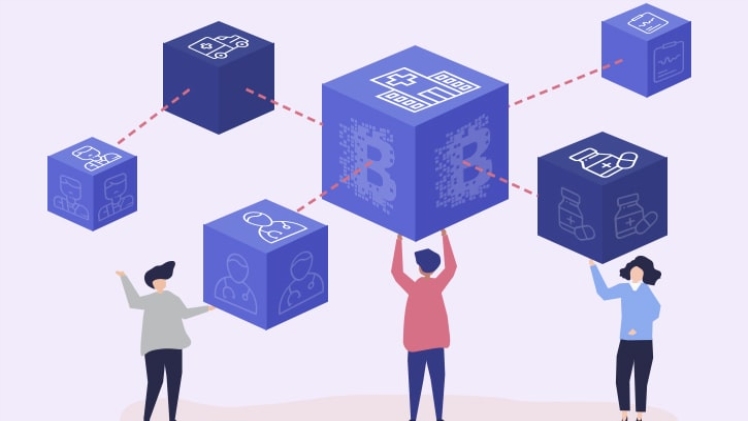With its capacity to deflate the present expenditure bubble and secure patient data, blockchain treatment may assist in relieving suffering. The technology that we use in this is to encrypt patient data to manage dangerous disease outbreaks securely. At least one country is excellent on the healthcare potential of the blockchain: Estonia.
Blockchain is a powerful technology for the safe exchange of information and access among many parties. It is a significant challenge for digital health, where the confidentiality and security of medical data play an essential role. But improving the quality of care cannot occur without further coordination in managing patient data throughout the health system and the possibility of analyzing medical data on the population level. In summary, blockchain can aid digital health by enabling data to be shared securely between fragmented healthcare systems with patient approval. Bitcoin is fast and global. Buy Bitcoin and Cryptocurrency as it is hassle-free, fee-free payments and easy access to the world’s most reliable blockchain
Blockchain
One of the most significant problems is to differentiate between genuine blockchain-based applications and hype. It isn’t easy to do because only a few critical, real-world instances of blockchain outside Bitcoin still exist. A highly balanced blend of potent cryptography and built-in incentives (in the form of Bitcoins or other crypto-tokens), blockchain’s most innovative proposal removes the need for a centrally controlled authority.
It distributes power to everyone in the blockchain ecosystem. In principle, it can therefore remove the requirement for a third party to digitally, securely, and impartially manage transactions between two entities that neither know nor rely on each other. It works rather well in the Bitcoin ecosystem, while it is in traditional corporate contexts. One of the long-term objectives of disruptive companies in blockchain operations is to decentralize the data economy, reclaim power from Google and other companies that competitively centralize large-scale datasets, and ensure that individuals and organizations use personal and proprietary data.
Applications of Blockchain:
-
Transparency of Blockchain
As in many other sectors, a key issue is to ensure that medical items come to validate their validity. A blockchain-based system to monitor products from the production point and through the supply chain at each level allows customers complete visibility of the goods they purchase. It is an industry top priority, particularly in emerging markets where counterfeit prescription drugs cause tens of thousands of lives yearly. It is also more critical for medical gadgets to spread rapidly with more excellent remote monitoring of health, therefore drawing bad actors’ interest. MediLedger is a notable example of a blockchain technology that allows firms to check the validity of the medication supply chain and expiration dates and other vital information.
-
Patient Data Security
The most popular blockchain healthcare use right now is keeping our vital medical information safe and protected, which is not unexpected. In the healthcare business, security is a significant concern. The criminals have stored credit card and health and genome test records. The potential of blockchain to maintain an inviolable, decentralized, and transparent log of data makes it a security technology ripple.
-
Electronic Health Records
Health care systems in all countries and regions face data siloes, such that patients and their healthcare professionals have an inadequate overview of medical history. In 2016, Johns Hopkins University presented data indicating that the third most significant cause of mortality in the United States was a medical mistake caused by poorly coordinated treatment. We can translate each new record attached to the blockchain in a unique hash function—a short chain of characters and numbers, whether a medical note, a prescription, or a test result. All hash functions are unique, and we can decrypt the data if the data owner – in this instance, the patient – agrees. For more precise and accurate information, you can visit the bitcoin loophole algorithm.
-
Smart contracts
Companies like Chronicled and Curisium provide blockchain-based systems in which different actors in the healthcare sector, including pharmaceutical companies, insurers, and health care providers, may authenticate their identities as organizations, log details and track the goods and services transactions. Payment details for those goods and services this sort of environment goes beyond supply chain management. Commercial partners and healthcare insurers may also function based on entirely digital and, in some cases, automated contractual conditions.
By sharing digital contracts between manufacturers, distributors, and medical groups, they can considerably minimize conflicts about payment chargeback for prescription medications and other commodities instead of each party having their versions of contracts. Chronicled reports that, because price structures regularly change, more than a million chargeback claims are filed amongst these players each year, over 5% of which are controversial and require a lengthy human settlement.
Similarly, shared healthcare may utilize intelligent contracts to manage patient medical insurance contracts where Curisium reports that 10% of claims are for contesting. As in other situations, insurance companies may employ more complex analytics to optimize health outcomes and costs if this data is digitized and readily available.
-
Safety
How much do we know about our medicine? Can we be sure that we didn’t manipulate it? Is it a genuine supplier? These are the main problems of the medical supply chain or the connections between the laboratory and the market.
Blockchain has significant consequences for pharmaceutical supply chain management and is decentralized to ensure almost complete transparency in the shipping process. When we make a drug leader, it marks the place of genesis (i.e., a laboratory). The directory will continue to collect information at all stages, including who handled it and where it was until it reaches the customer. The method may even monitor labor expenses and emissions of trash.

